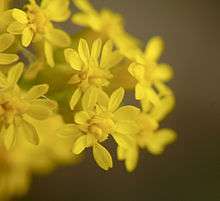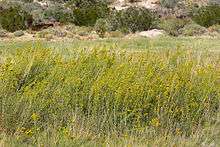Goldenrod
| Goldenrod | |
|---|---|
 | |
| Solidago virgaurea var. leiocarpa | |
| Scientific classification | |
| Kingdom: | Plantae |
| (unranked): | Angiosperms |
| (unranked): | Eudicots |
| (unranked): | Asterids |
| Order: | Asterales |
| Family: | Asteraceae |
| Subfamily: | Asteroideae |
| Tribe: | Astereae |
| Genus: | Solidago L. 1753 not Mill. 1754 |
| Synonyms[1] | |
| |
Solidago, commonly called goldenrods, is a genus of about 100[1] to 120[2] species of flowering plants in the aster family, Asteraceae. Most are herbaceous perennial species found in open areas such as meadows, prairies, and savannas. They are mostly native to North America, including Mexico; a few species are native to South America and Eurasia.[1] Some American species have also been introduced into Europe and other parts of the world.
Description

Solidago species are perennials growing from woody caudices or rhizomes. Their stems ranges from decumbent (crawling) to ascending or erect, with a range of heights going from 5 centimetres (2.0 in) to over a meter. Most species are unbranched, but some do display branching in the upper part of the plant. Both leaves and stems vary from glabrous (hairless) to various forms of pubescence (strigose, strigillose, hispid, stipitate-glandular or villous). In some species, the basal leaves are shed before flowering. The leaf margins are most commonly entire, but often display heavier serration. Some leaves may display trinerved venation rather than the pinnate venation usual across Asteraceae.[1]
The flower heads are usually of the radiate type (typical daisy flower heads with distinct ray and disc florets) but sometimes discoid (with only disc florets of mixed, sterile, male and bisexual types). Only ray florets are female, others are male, hermaphroditic or entire sterile. Head involucres are campanulate to cylindric or attenuate. Floret corollas are usually yellow, but white in the ray florets of a few species (such as Solidago bicolor); they are typically hairless. Heads usually include between 2 and 35 disc florets, but in some species this may go up to 60. Filaments are inserted closer to the base of the corolla than its middle. Numerous heads are usually grouped in complex compound inflorescences where heads are arranged in multiple racemes, panicles, corymbs, or secund arrays (with florets all on the same side).[1]
Solidago cypselae are narrowly obconic to cylindrical in shape, and they are sometimes somewhat compressed. They have eight to 10 ribs usually and are hairless or moderately hispid. The Pappus is very big with barbellate bristles.[1]
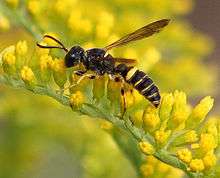
The many goldenrod species can be difficult to distinguish, due to their similar bright, golden-yellow flower heads that bloom in late summer. Propagation is by wind-disseminated seeds or by spreading underground rhizomes which can form colonies of vegetative clones of a single plant. They are mostly short-day plants and bloom in late summer and early fall. Some species produce abundant nectar when moisture is plentiful, or when the weather is warm and sunny.
Use and cultivation
Young goldenrod leaves are edible.[3] Native Americans used the seeds of some species for food.[4] Herbal teas are sometimes made with goldenrod.[5]
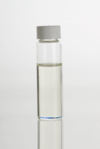
Goldenrod often is inaccurately said to cause hay fever in humans.[6] The pollen causing this allergic reaction is produced mainly by ragweed (Ambrosia sp.), blooming at the same time as the goldenrod and pollinated by wind. Goldenrod pollen is too heavy and sticky to be blown far from the flowers, and is pollinated mainly by insects.[6] Frequent handling of goldenrod and other flowers, however, can cause allergic reactions, sometimes irritating enough to force florists to change occupation.[7] Goldenrods are attractive sources of nectar for bees, flies, wasps, and butterflies. Honey from goldenrods often is dark and strong because of admixtures of other nectars. However, when honey flow is strong, a light (often water-clear), spicy-tasting monofloral honey is produced. While the bees are ripening the honey produced from goldenrods, it has a rank odor and taste; the finished honey is much milder.
Goldenrods are, in some places, considered a sign of good luck or good fortune.[8] They are considered weeds by many in North America, but they are prized as garden plants in Europe, where British gardeners adopted goldenrod as a garden subject long before Americans did. Goldenrod began to gain some acceptance in American gardening (other than wildflower gardening) during the 1980s.
They have become invasive species in other parts of the world, including China; Solidago canadensis, which was introduced as a garden plant in Central Europe, has become common in the wild, and in Germany is considered an invasive species that displaces native vegetation from its natural habitat.
Goldenrod species are used as a food source by the larvae of many Lepidoptera species. The invading larva may induce the plant to form a bulbous tissue mass called a gall around it, upon which the larva then feeds. Various parasitoid wasps find these galls and lay eggs in the larvae, penetrating the bulb with their ovipositors. Woodpeckers are known to peck open the galls and eat the insects in the center.[9]
Cultivated species
Cultivated goldenrods include S. bicolor, S. caesia, S. canadensis, S. cutleri, S. riddellii, S. rigida, S. shortii, and S. virgaurea.[10]
A number of cultivars have been selected, including several of hybrid origin. A putative hybrid with aster, known as ×Solidaster is less unruly, with pale yellow flowers, equally suitable for dried arrangements. Molecular and other evidence points to ×Solidaster (at least the cultivar 'Lemore') being a hybrid of Solidago ptarmicoides and Solidago canadensis, the former now in Solidago, but likely the "aster" in question.[11]
The cultivars 'Goldenmosa'[12] and S. × luteus 'Lemore'[13] have gained the Royal Horticultural Society's Award of Garden Merit.
Industrial use
Inventor Thomas Edison experimented with goldenrod to produce rubber, which it contains naturally.[14] Edison created a fertilization and cultivation process to maximize the rubber content in each plant. His experiments produced a 12-foot-tall (3.7 m) plant that yielded as much as 12% rubber. The tires on the Model T given to him by his friend Henry Ford were made from goldenrod. Like George Washington Carver, Henry Ford was deeply interested in the regenerative properties of soil and the potential of alternative crops such as peanuts and soybeans to produce plastics, paint, fuel and other products. Ford had long believed that the world would eventually need a substitute for gasoline, and supported the production of ethanol (or grain alcohol) as an alternative fuel. In 1942, he would showcase a car with a lightweight plastic body made from soybeans. Ford and Carver began corresponding via letter in 1934, and their mutual admiration deepened after George Washington Carver made a visit to Michigan in 1937. As Douglas Brinkley writes in "Wheels for the World," his history of Ford, the automaker donated generously to the Tuskegee Institute, helping finance Carver's experiments, and Carver in turn spent a period of time helping to oversee crops at the Ford plantation in Ways, Georgia.
By the time World War II began, Ford had made repeated journeys to Tuskegee to convince George Washington Carver to come to Dearborn and help him develop a synthetic rubber to help compensate for wartime rubber shortages. Carver arrived on July 19, 1942, and set up a laboratory in an old water works building in Dearborn. He and Ford experimented with different crops, including sweet potatoes and dandelions, eventually devising a way to make the rubber substitute from goldenrod, a plant weed commercially viable.[15] Carver died in January 1943, Ford in April 1947, but the relationship between their two institutions continued to flourish: As recently as the late 1990s, Ford awarded grants of $4 million over two years to the George Washington Carver School at Tuskegee.
Extensive process development was conducted during World War II to commercialize goldenrod as a source of rubber.[16] The rubber is only contained in the leaves, not the stems or blooms. Typical rubber content of the leaves is 7%. The resulting rubber is of low molecular weight, resulting in an excessively tacky compound with poor tensile properties.
Traditional medicine
Solidago virgaurea is used in a traditional kidney tonic by practitioners of herbal medicine to counter inflammation and irritation caused by bacterial infections or kidney stones.[17][18] Goldenrod is also used in some formulas for cleansing of the kidney or bladder during a healing fast, in conjunction with potassium broth and specific juices.[18] Some Native American cultures traditionally chew the leaves to relieve sore throats, and the roots to relieve toothaches.[8]
Cultural significance
The goldenrod is the state flower of the U.S. states of Kentucky (adopted 1926) and Nebraska (adopted 1895). Goldenrod was recently named the state wildflower of South Carolina. The sweet goldenrod (Solidago odora) is the state herb of Delaware.[19] Goldenrod was the state flower of Alabama, but it was later rejected in favour of the camellia.
In the Midwestern United States, the blooming of goldenrods in August is a reminder that it will soon be time for children to go back to school after summer vacation.[20]
Diversity



_(8155898363).jpg)

- Accepted Species[21]
- Solidago albopilosa E.L.Braun – whitehair goldenrod
- Solidago altiplanities C.E.S. Taylor & R.J.Taylor – high plains goldenrod
- Solidago altissima L. – Canada goldenrod, late goldenrod
- Solidago amplexicaulis Torr. & A.Gray
- Solidago arenicola B.R. Keener & Kral – southern racemose goldenrod
- Solidago argentinensis López Laphitz, Rita María & Semple
- Solidago arguta Ait. – Atlantic goldenrod, forest goldenrod, toothed goldenrod, cut-leaf goldenrod
- Solidago aurea Spreng.
- Solidago auriculata Shuttlw. ex Blake – eared goldenrod, clasping goldenrod
- Solidago bartramiana Fernald
- Solidago bicolor L. – white goldenrod, silverrod
- Solidago brachyphylla Chapman – Dixie goldenrod
- Solidago brendiae Semple
- Solidago buckleyi Torr. & Gray – Buckley's goldenrod
- Solidago caesia L. – wreath goldenrod, axillary goldenrod, bluestem goldenrod, woodland goldenrod
- Solidago calcicola (Fernald) Fernald
- Solidago californica Nutt.
- Solidago canadensis L. : Canada goldenrod, Canadian goldenrod, common goldenrod
- Solidago chilensis Meyen
- Solidago compacta Turcz.
- Solidago confinis A.Gray
- Solidago coreana (Nakai) H.S.Pak
- Solidago curtisii Torr. & A.Gray – mountain decumbent goldenrod, Curtis' goldenrod
- Solidago dahurica (Kitagawa) Kitagawa ex Juzepczuk
- Solidago decurrens Loureiro
- Solidago delicatula Small – elmleaf goldenrod, smooth elm-leaf goldenrod
- Solidago drummondii Torr. & A.Gray. – Drummond's goldenrod
- Solidago durangensis G.L.Nesom
- Solidago elongata Nutt. – West Coast Canada goldenrod, Cascade Canada goldenrod
- Solidago erecta Nutt. – showy goldenrod, slender goldenrod
- Solidago ericamerioides G.L.Nesom
- Solidago faucibus Wieboldt – gorge goldenrod
- Solidago fistulosa P.Mill. – pine-barren goldenrod
- Solidago flexicaulis L. – zigzag goldenrod, broadleaf goldenrod
- Solidago gattingeri Chapman – Gattinger's goldenrod
- Solidago gigantea Ait. – giant goldenrod, tall goldenrod, early goldenrod, smooth goldenrod
- Solidago glabra Desf.
- Solidago glomerata Michx. – clustered goldenrod, skunk goldenrod
- Solidago guiradonis A.Gray – Guirado's goldenrod
- Solidago gypsophila G.L.Nesom
- Solidago hintoniorum G.L.Nesom
- Solidago hispida Muhl. ex Willd. – hairy goldenrod
- Solidago houghtonii Torr. & A.Gray ex A.Gray – Houghton's goldenrod
- Solidago humilis Mill.
- Solidago inornata Lunell
- Solidago juliae G.L.Nesom – Julia's goldenrod
- Solidago juncea Ait. – early goldenrod
- Solidago kralii Semple – Kral's goldenrod
- Solidago kuhistanica Juz.
- Solidago kurilensis Juz.
- Solidago lancifolia Torr. & A.Gray – lance-leaf goldenrod
- Solidago latissimifolia P.Mill. – Elliott's goldenrod
- Solidago leavenworthii Torr. & A.Gray – Leavenworth's goldenrod
- Solidago leiocarpa DC. in DC. &. A.DC. – Cutler's alpine goldenrod
- Solidago lepida DC. – western Canada goldenrod
- Solidago ludoviciana (Gray) Small – Louisiana goldenrod
- Solidago macrophylla Pursh – largeleaf goldenrod
- Solidago macvaughii G.L.Nesom
- Solidago microglossa DC.
- Solidago minutissima (Makino) Kitam.
- Solidago missouriensis Nutt. – Missouri goldenrod, prairie goldenrod, Tolmie's goldenrod
- Solidago mollis Bartl. – velvety goldenrod, soft goldenrod, woolly goldenrod
- Solidago multiradiata Ait. – Rocky Mountain goldenrod, alpine goldenrod, northern goldenrod, manyray goldenrod
- Solidago nana Nutt. – baby goldenrod, dwarf goldenrod, gray goldenrod
- Solidago nemoralis Ait. – gray goldenrod, dyersweed goldenrod, old-field goldenrod
- Solidago nitida Torr. & A.Gray – shiny goldenrod
- Solidago odora Ait. – anise-scented goldenrod, sweet goldenrod, fragrant goldenrod
- Solidago ohioensis Riddell – Ohio goldenrod
- Solidago orientalis G.L.Nesom
- Solidago ouachitensis C.E.S.Taylor & R.J.Taylor – Ouachita Mountains goldenrod
- Solidago ovata Friesner
- Solidago pacifica Juzepczuk
- Solidago paniculata DC.
- Solidago patagonica Phil.
- Solidago patula Muhl. ex Willd. – roundleaf goldenrod, roughleaf goldenrod
- Solidago petiolaris Ait. – downy ragged goldenrod
- Solidago perornata Lunell
- Solidago pilosa Mill.
- Solidago pinetorum Small – Small's goldenrod
- Solidago plumosa Small – plumed goldenrod, plumose goldenrod, Yadkin River goldenrod
- Solidago pringlei Fernald
- Solidago procera Aiton
- Solidago ptarmicoides (Torr. & A.Gray) B.Boivin – white flat-top goldenrod, upland white aster
- Solidago puberula Nutt. – downy goldenrod
- Solidago pulchra Small – Carolina goldenrod
- Solidago radula Nutt. – western rough goldenrod
- Solidago riddellii Frank ex Riddell – Riddell's goldenrod
- Solidago rigida L. – rigid goldenrod, stiff-leaf goldenrod
- Solidago roanensis Porter – Roan Mountain goldenrod
- Solidago rugosa P.Mill. – wrinkleleaf goldenrod, rough-stemmed goldenrod
- Solidago rupestris Raf. – rock goldenrod
- Solidago satanica Lunell
- Solidago sciaphila Steele – shadowy goldenrod
- Solidago sempervirens L. – seaside goldenrod, salt-marsh goldenrod
- Solidago serotina Retz.
- Solidago shortii Torr. & A.Gray – Short's goldenrod
- Solidago simplex Kunth : Mt. Albert goldenrod, sticky goldenrod
- Solidago spathulata DC. – coast goldenrod
- Solidago speciosa Nutt. – showy goldenrod, noble goldenrod
- Solidago spectabilis (D.C.Eat.) A.Gray – Nevada goldenrod, basin goldenrod
- Solidago sphacelata Raf. – autumn goldenrod, false goldenrod
- Solidago spithamaea M.A.Curtis – Blue Ridge goldenrod, skunk goldenrod
- Solidago spiraeifolia Fisch. ex Herder
- Solidago squarrosa Nutt. – stout goldenrod
- Solidago stricta Ait. – wand goldenrod, willow-leaf goldenrod
- Solidago tarda Mack. – Atlantic goldenrod
- Solidago tortifolia Ell. – twistleaf goldenrod
- Solidago uliginosa Nutt. – bog goldenrod, fall goldenrod
- Solidago ulmifolia Muhl. ex Willd. – elmleaf goldenrod
- Solidago velutina DC. – threenerve goldenrod, velvety goldenrod
- Solidago verna M.A.Curtis – springflowering goldenrod
- Solidago villosicarpa LeBlond – glandular wand goldenrod, hairy-seed goldenrod
- Solidago virgaurea L. – European goldenrod
- Solidago wrightii A.Gray – Wright's goldenrod
- Solidago yokusaiana Makino
- Natural hybrids[21]
- Solidago × asperula Desf. (S. rugosa × S. sempervirens)
- Solidago × beaudryi Boivin (S. rugosa × S. uliginosa)
- Solidago × calcicola (Fernald) Fernald – limestone goldenrod
- Solidago × erskinei Boivin (S. canadensis × S. sempervirens)
- Solidago × ovata Friesner (S. sphacelata × S. ulmifolia)
- Solidago × ulmicaesia Friesner (S. caesia × S. ulmifolia)
- Formerly included[21]
Numerous species formerly considered members of Solidago are now regarded as better suited to other genera, including Brintonia, Duhaldea, Euthamia, Gundlachia, Inula, Jacobaea, Leptostelma, Olearia, Oligoneuron, Psiadia, Senecio, Sphagneticola, Symphyotrichum, Trixis, Xylothamia
References
- 1 2 3 4 5 6 "Solidago". Flora of North America.
- ↑ Solidago. Flora of China.
- ↑ Solidago missouriensis, Missouri goldenrod. Northern Rockies Natural History Guide. University of Montana, Missoula.
- ↑ Solidago nemoralis. Native American Ethnobotany. University of Michigan, Dearborn.
- ↑ Goldenrod. Complementary and Alternative Medicine Guide. University of Maryland Medical Center.
- 1 2 Marshall Cavendish Corporation (2001). Endangered Wildlife and Plants of the World: Fra-Igu. Marshall Cavendish. pp. 632–. ISBN 978-0-7614-7199-8.
- ↑ de Jong, N. W.; et al. (Feb 1998). "Occupational allergy caused by flowers". Allergy. 53 (2): 204–9. ISSN 0105-4538. PMID 9534922. doi:10.1111/j.1398-9995.1998.tb03872.x.
- 1 2 Silverthorne, E. (2002). Legends and Lore of Texas Wildflowers. Texas A&M University Press. pp. 61–. ISBN 978-1-58544-230-0. Retrieved 4 October 2010.
- ↑ Shealers, D. A.; et al. (July 1999). "Foraging patterns of Eastern gray squirrels (Sciurus carolinensis) on goldenrod gall insects, a potentially important winter food resource". The American Midland Naturalist. 142 (1): 102–109. ISSN 0003-0031. doi:10.1674/0003-0031(1999)142[0102:FPOEGS]2.0.CO;2.
- ↑ Jelitto, L.; Schacht, W. (1995). Hardy Herbaceous Perennials: A-K ; Vol. 2, L-Z. Timber Press. p. 629. ISBN 978-0-88192-159-5. Retrieved 4 October 2010.
- ↑ Schilling, E. E.; et al. (2008). "Molecular analysis of Solidaster cv. Lemore, a hybrid goldenrod (Asteraceae)" (PDF). Journal Botanical Research Institute of Texas. 2: 7–18.
- ↑ "RHS Plant Selector - Solidago 'Goldenmosa'". Retrieved 10 June 2013.
- ↑ "RHS Plant Selector - Solidago × luteus 'Lemore'". Retrieved 10 June 2013.
- ↑ "Goldenrod Rubber". Time Magazine. December 16, 1929. Retrieved June 6, 2017.
- ↑ "George Washington Carver begins experimental project with Henry Ford - Jul 19, 1942 - HISTORY.com". history.com. History (U.S. TV channel). Retrieved 20 May 2015.
- ↑ "Extraction, characterization, and utilization of goldenrod rubber". U S Dept of Agriculture. 9 Sep 1944. Retrieved 27 Sep 2011.
- ↑ Melzig, M. F. (November 2004). "Goldenrod--a classical exponent in the urological phytotherapy". Wiener medizinische Wochenschrift (1946). 154 (21–22): 523–7. ISSN 0043-5341. PMID 15638071. doi:10.1007/s10354-004-0118-4.
- 1 2 Campion, K. (1995). Holistic Woman's Herbal - How to Achieve Health and Well-Being at Any Age. Barnes & Noble, Inc. 1995. pp 65 and 96. ISBN 978-0-7607-1030-2
- ↑ State Seal, Song and Symbols of Delaware
- ↑ Cunningham, D. (May 2001). "Goldenrod and Other Essences for School Transitions". Vibration Magazine: The Journal of Vibrational/Flower Essences.
- 1 2 3 The Plant List, search for Solidago
External links
| Wikimedia Commons has media related to Solidago. |
| Wikispecies has information related to: Solidago |
- Goldenrod identification. Andy's Northern Ontario Wildflowers.
- Goldenrods Group. Ontario Wildflowers.
- Solidago: Goldenrods. Astereae Lab. University of Waterloo (Canada).

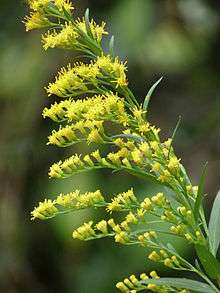
.jpg)

